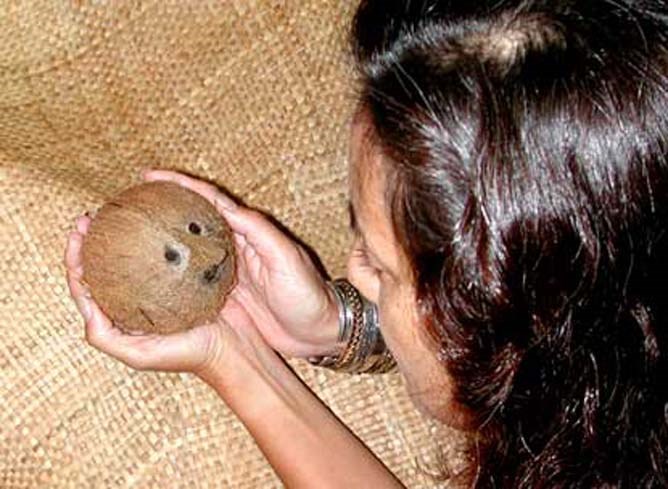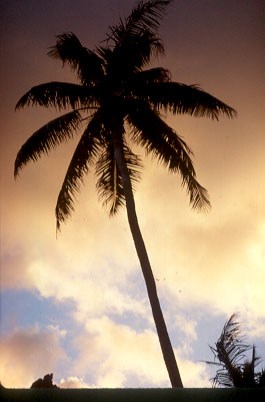
NPS / Bryan Harry. |
|
Widespread stories across the Pacific described the most beautiful woman in all the islands--a Samoan girl. named Sina. The King of Fiji, the Tui Fiti, heard this and decided to go there and win Sina for his wife. Using all his powers of Fijian magic Tui Fiti turned himself into a young eel or tuna and swam with the ocean currents to Samoa.* One day as Sina dipped seawater for her mother's cooking she noticed the young tuna in a lagoon pool. Gathering it in her calabash, she took it home for a pet. Sina kept the tuna in a bowl and nurtured it carefully. When the tuna grew too large for the bowl, Sina placed it in the spring near their fale, but the tuna soon outgrew this small pool. At her mother's suggestion Sina caught the tuna and put it into the much larger village bathing pool, where it hid under a ledge. Though the pool was used by everyone, no one but Sina ever saw the tuna, and when Sina came to bathe the tuna would come out of hiding playfully and affectionately encircling her in gliding and wriggling embrace. Sina now became afraid of the tuna which had become very large and she wouldn't bathe in the village pool. Instead, she bathed by the tiny spring near her fale--but whenever Sina bathed, the tuna appeared in the small spring's pool. Now afraid, and angry, Sina left her village to escape the tuna. While everyone slept, she slipped away and began a long journey to another village. Along the way, when thirsty, she would stop at trailside springs to drink, but at every pool the tuna always appeared. Afraid, Sina kept traveling-village to village, and island to island-but everywhere to her distress the tuna followed. In desperation Sina came to the fono and sat between two speechmakers. Then all sat in fear as they say a huge tuna approach across the open grounds to stop in front of Sina and say, "Beautiful Sina, forgive me but listen to me. I am the Tui-Fiti from faraway Fiji. I came to seek you for my wife. But I have long lost my magic and cannot change myself back into a man. I have traveled long and I am tired. Soon I will die. I have a wish to beg of you. Sina, when I die cut off my head and bury it in front of your fale. A tree will grow from it-a tree that will be very useful to you. When the northern wind fails to blow take its leaves and weave a fan to cool yourself. When it bears fruit drink from this when you are thirsty. Sina, and when you do, you will be kissing me." 
The broken-hearted tuna died and Sina carefully planted its head. Soon a plant grew there and it became a tree like no one before had ever seen. This was the first coconut tree**. Notice when you next eat a coconut--look for the eyes and mouth of Tui Fiti on the end of "Sina's tuna."
|
Last updated: February 28, 2015
